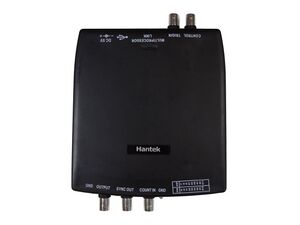Difference between revisions of "Hantek DDS-3X25"
Jump to navigation
Jump to search
| Line 21: | Line 21: | ||
==== 0xA0: configure ==== | ==== 0xA0: configure ==== | ||
Configures the device. The payload is 6 bytes | Configures the device. The payload is 6 bytes: | ||
{| border="0" width="95%" style="font-size: smaller" class="alternategrey sigroktable" | {| border="0" width="95%" style="font-size: smaller" class="alternategrey sigroktable" | ||
| Line 125: | Line 125: | ||
|} | |} | ||
THe response is 10 bytes: | |||
* the first 2 bytes are always 0 | |||
* in frequency measurement mode: | |||
** four bytes for the current frequency measurement, in network order. Multiply by 2 to get the actual frequency readout. | |||
** four bytes for a "tick counter" in network order. This has the number of ticks per second, and is used to derive the frequency. ''Assuming a 100Mhz clock, this counter differs up to 4.17% at 8Mhz from the derived frequency -- investigate.'' | |||
* in counter mode: | |||
** four bytes for the current counter, in network order. | |||
** four bytes denoting the smoothed out frequency, identical to the first four bytes in frequency measurement mode. | |||
[[Category:Device]] | [[Category:Device]] | ||
[[Category:Function generator]] | [[Category:Function generator]] | ||
[[Category:Planned]] | [[Category:Planned]] | ||
Revision as of 23:54, 5 April 2013
The Hantek DDS-3X25 is a 25MHz PC-based function generator. It has no external controls, requiring a USB connection to a computer.
Hardware
TODO.
Photos
Protocol
0xA0: configure
Configures the device. The payload is 6 bytes:
| Byte | Bit | Description |
|---|---|---|
| 1 | Mode | |
| 7 | ||
| 6 | ||
| 5 | 1 = Reset external trigger (send only once) | |
| 4 | 1 = External trigger mode enabled | |
| 3 | External trigger: 0 = falling, 1 = rising | |
| 2 | 0 = continuous, 1 = single wave | |
| 1 | Counter reset: 0 = leave, 1 = reset | |
| 0 | Measurement: 0 = frequency, 1 = counter | |
| 2 | ||
| 7 | ||
| 6 | ||
| 5 | ||
| 4 | ||
| 3 | ||
| 2 | ||
| 1 | ||
| 0 | Output: 0 = pattern generator, 1 = programmable output | |
| 3 | Digital I/O pins, bits 0-7 | |
| 4 | Bits 0-3 = digital I/O pins bits 8-11, bits 4-7 unused | |
| 5 | Clock divider, based on 48KHz clock | |
| 6 |
THe response is 10 bytes:
- the first 2 bytes are always 0
- in frequency measurement mode:
- four bytes for the current frequency measurement, in network order. Multiply by 2 to get the actual frequency readout.
- four bytes for a "tick counter" in network order. This has the number of ticks per second, and is used to derive the frequency. Assuming a 100Mhz clock, this counter differs up to 4.17% at 8Mhz from the derived frequency -- investigate.
- in counter mode:
- four bytes for the current counter, in network order.
- four bytes denoting the smoothed out frequency, identical to the first four bytes in frequency measurement mode.





